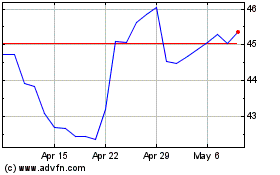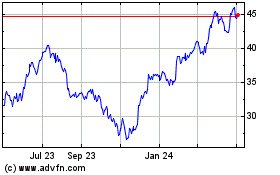By Mike Colias and Nora Naughton
This article is being republished as part of our daily
reproduction of WSJ.com articles that also appeared in the U.S.
print edition of The Wall Street Journal (October 19, 2019).
United Auto Workers leaders, who earlier this week voted to
extend a more than monthlong strike at General Motors Co., now face
a critical task: selling a new labor deal to rank-and-file members
with high expectations.
The proposed contract struck by UAW and GM negotiators on
Wednesday includes some significant gains, including better wages,
longer-term job security for temporary workers and a record $11,000
signing bonus if the deal is ratified.
But GM will proceed with closing three now-idled U.S. plants,
including a major assembly operation in Lordstown, Ohio, and it
made no commitment to relocate Mexico production to the U.S. -- a
change the UAW had pressed for during talks.
During a meeting in Detroit on Thursday, nearly 200 union-hall
leaders from across the country spent six hours studying the
details of the 351-page agreement, according to people who attended
the meeting.
Many of the local union officials were upset the UAW couldn't
prevent the closure of Lordstown plant, and some were concerned the
$7.7 billion in new investment GM committed to U.S. factories would
fall short in securing future work, these people said. There also
was much discussion about whether the agreement provided enough
safeguards for temporary workers, they said.
The attention to detail in the six-hour meeting underscored the
tough sell that lies ahead for factory-level union officials in
pitching the agreement to the UAW's more than 46,000 GM workers.
Voting on the new four-year labor pact begins Saturday at dozens of
GM facilities and is expected to wrap up about a week later. A
majority must approve the deal for it to go into effect.
With the nationwide strike now stretching into a second month,
workers say they have high hopes their time on the picket lines
will be rewarded.
"We've been out here for a long time. Was it worth it?" said
Chad Fabbro, a financial secretary at the UAW's local in Flint,
Mich. "There are a lot of pluses in this contract, but people did
expect more. Half the membership is excited and half is not."
The rare decision to stay on strike even after reaching a
tentative agreement will prolong the pain for both sides.
By the time final ballots are in on Oct. 25, GM's losses could
grow by an additional $700 million roughly, surpassing $2.5 billion
since the strike began, analysts estimate. The average full-time
worker will have missed take-home pay of about $6,000.
The strike also has disrupted production at GM operations in
Canada and Mexico. On Friday, GM said it suspended production of
the Chevrolet Blazer SUV in Mexico because of strike-related parts
shortages.
Still, Wall Street analysts said the terms of deal shouldn't
significantly change GM's financial outlook. RBC Capital pegged the
cost increase from the contract at around $100 million annually,
along with a nearly $500 million outlay for the signing bonus.
"The financial implications of the deal don't look too onerous
for GM," RBC Capital analyst Joseph Spak wrote in an investor note
Friday. Moody's Investors Service said the contract should allow GM
to shift more of its production to trucks and sport-utility
vehicles, which carry healthy profit margins.
Ratification isn't assured, analysts said. In 2015, skilled
trade workers at GM initially rejected the tentative deal, even
though production workers approved it by a narrow margin.
Negotiators had to go back to clarify some language before the deal
was fully approved.
Heading into contract talks, the UAW leadership was already
mired in a corruption scandal that was eroding confidence from some
members.
Workers could also be upset the union was unable to persuade GM
to relocate production to the U.S. from Mexico, said Arthur
Wheaton, a professor of labor studies at Cornell University.
In the days before the tentative deal was reached, UAW leaders
publicly slammed GM, claiming the company was resistant to shifting
more production to the U.S. from foreign countries.
"It's not a slam dunk," Mr. Wheaton said of ratification.
Many workers are still on the fence, saying they will focus
their attention on plant investments and job security when they
cast their votes.
"This labor movement wasn't about bonuses, it was about job
security in the U.S.," said Chrissy Defelice, who works at GM's
casting plant in Bedford, Ind. "I'm not doing anything until I see
what job security we have in the contract."
About $3 billion of the $7.7 billion slated for U.S. factories
under the deal would go toward retooling a Detroit plant to make
electric pickup trucks and vans, securing a future for a facility
previously targeted for closure.
GM also said it would spend an additional $1.3 billion on
projects that fall outside the contract terms, including a new
facility near the Lordstown plant that will make battery cells for
electric vehicles and be staffed by UAW-represented workers.
"We're hoping that these electric and battery investments will
secure jobs," said Holli Murphy, president of a UAW chapter that
represents workers at a GM pickup-truck factory in Fort Wayne, Ind.
"But that's a hard pill for our membership to swallow, because it's
betting on the unknown."
Write to Mike Colias at Mike.Colias@wsj.com
(END) Dow Jones Newswires
October 19, 2019 02:47 ET (06:47 GMT)
Copyright (c) 2019 Dow Jones & Company, Inc.
General Motors (NYSE:GM)
Historical Stock Chart
From Mar 2024 to Apr 2024

General Motors (NYSE:GM)
Historical Stock Chart
From Apr 2023 to Apr 2024
